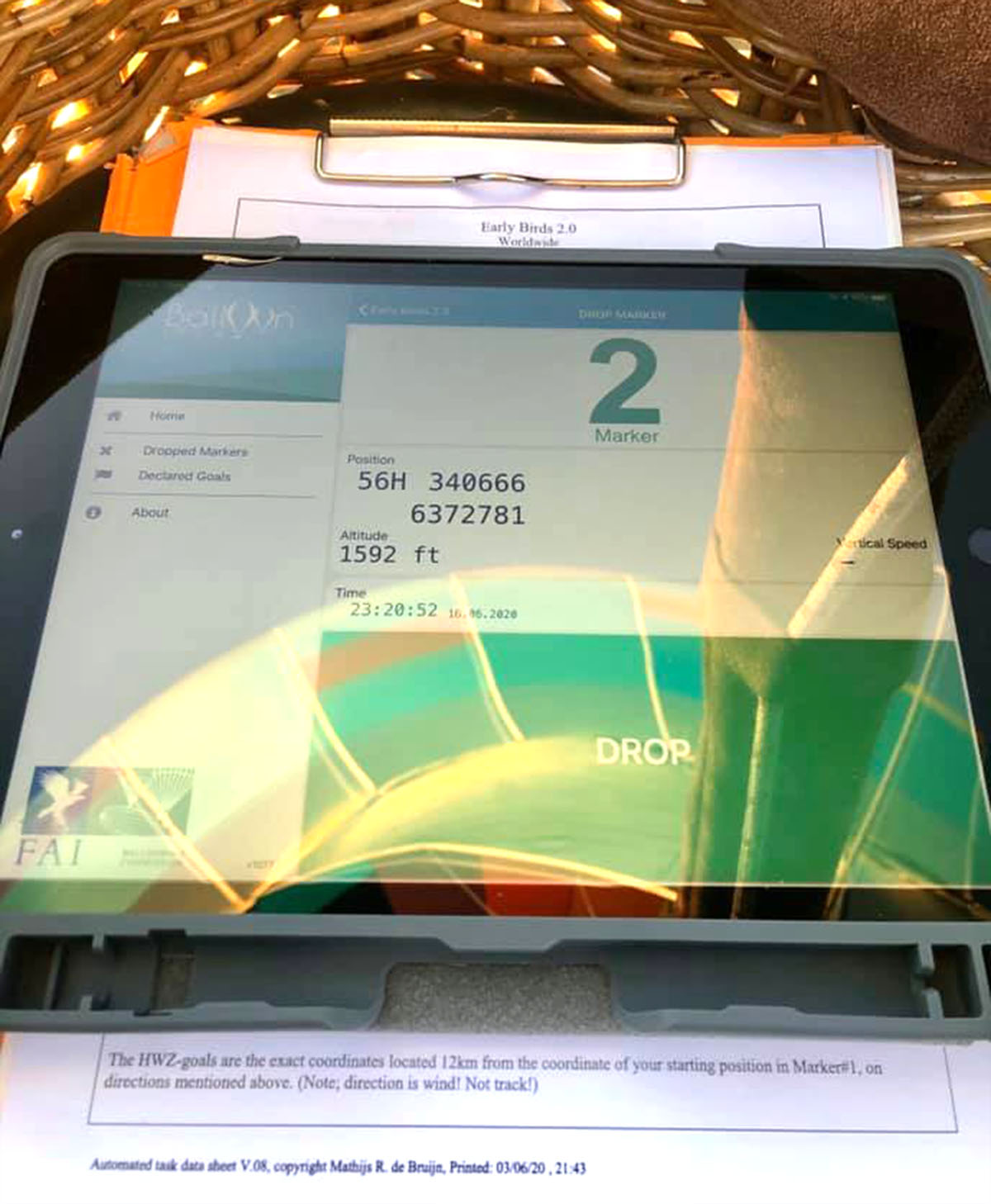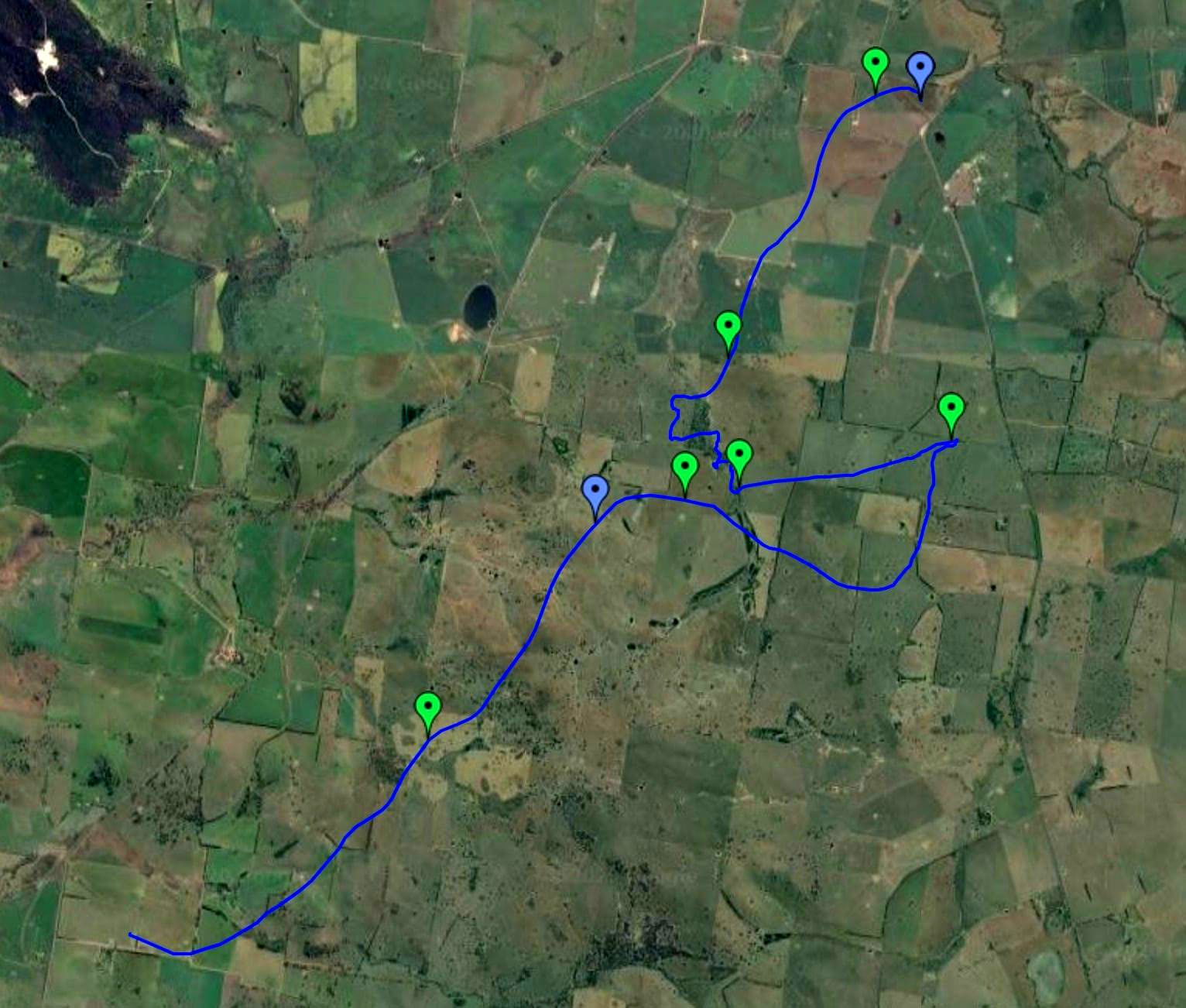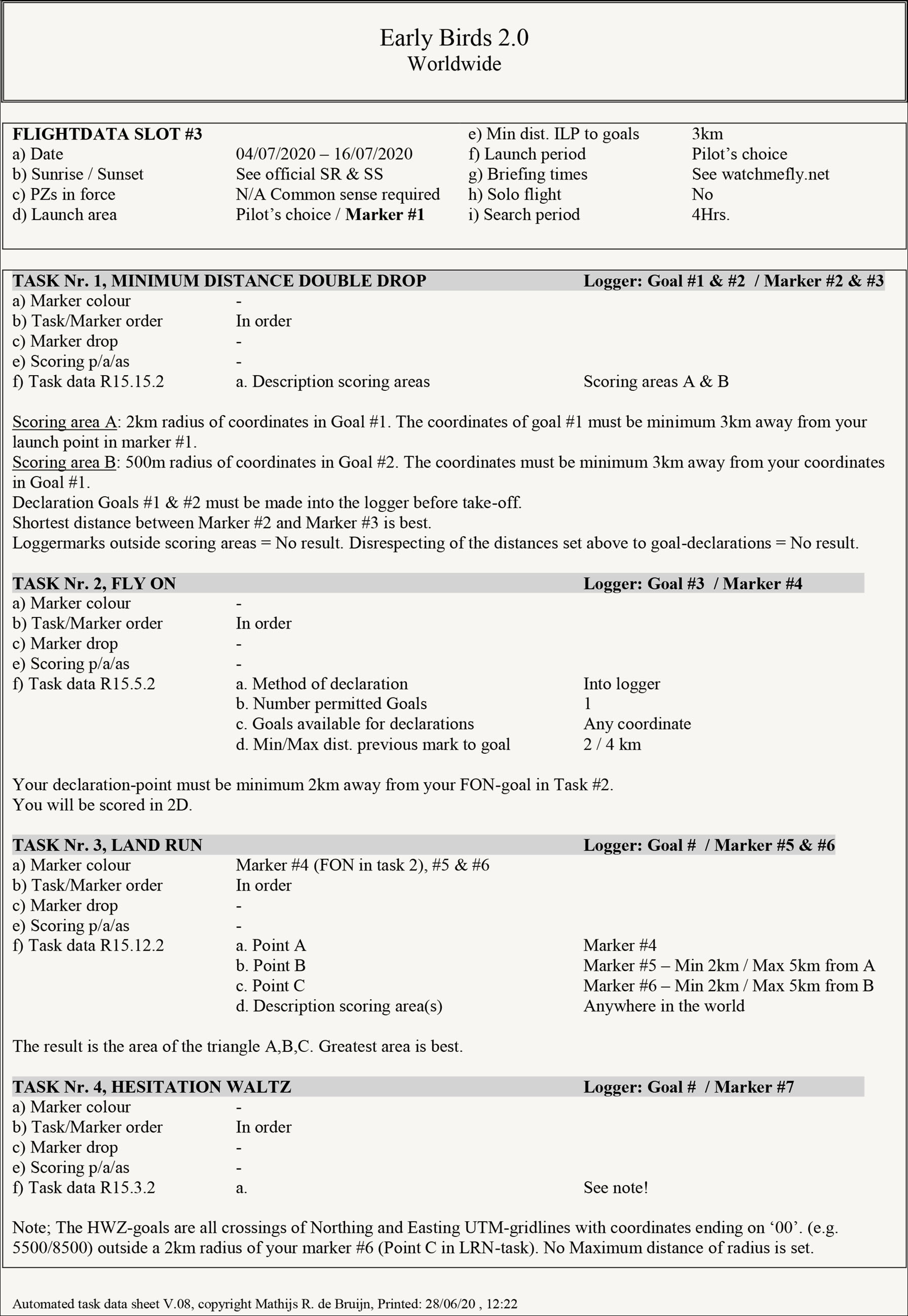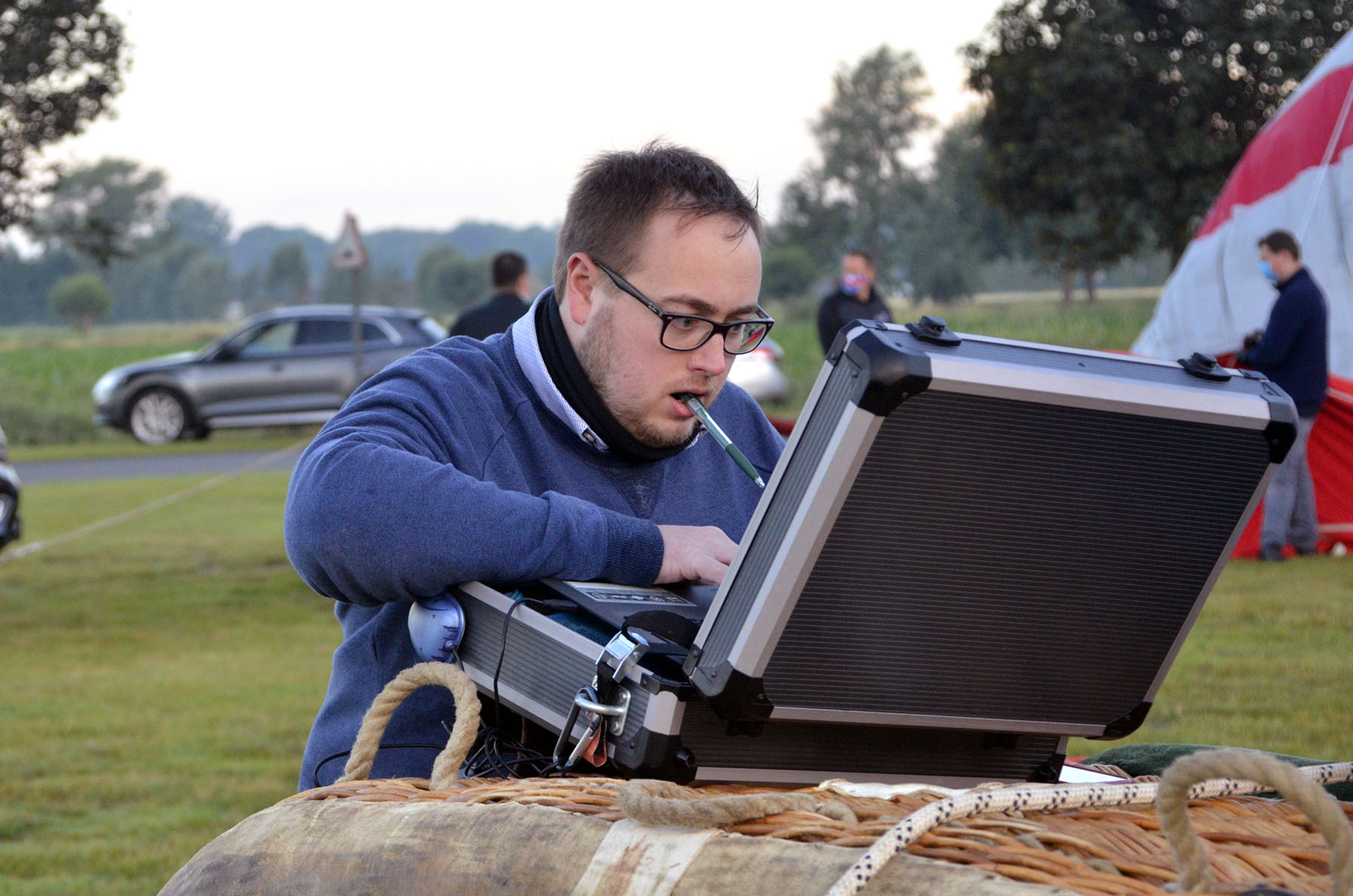Early Birds 2.0 worldwide balloon competition
Story by Jonas Maes, Event Director, Early Birds 2.0 (Belgium)
THE IDEA
End of May 2020. We are in the middle of the Covid-19 crisis and almost all national and international competitions have been, or will be, canceled. This is also the case with the Belgian Balloon Trophy, a well-known competition with (traditionally) a strong international field of participants. As for previous editions, I was asked to lead this competition and to provide the participants with some fun and exciting task-setting. Unfortunately, Ballooning has been banned in Belgium for some time, but has recently been re-allowed, albeit under strict conditions.
During a sunny afternoon I received a phone call from competition pilot Tom Deleersnyder, asking if we could put something together to do competitive ballooning. Pilot Philippe De Cock also contacted me that weekend with the same question. I asked them for a few days to look at this and promised to get back to them soon. But how…?
Balloon races are normally organised at a fixed location, with a predetermined airspace, where all pilots must fly the assigned tasks. There is a general briefing at the start of the event, and there are task briefings for each flight, where the task sheet (the list of assignments to be completed for each flight) is gone through and the pilots can ask questions if needed. The presence of all participants is mandatory. More than half the tasks are also flown and scored by means of a physical marker drop, on a physical target somewhere in a field.
All the above points are very difficult, considering distance rules, red zones, personal bubbles, etc.
Now that we are used to flying competitions with loggers, and where the Watchmefly.net platform has become a useful and current medium, it did not seem impossible to me to come up with something attractive, especially as the Balloon Live App has recently been introduced. This is an app that can be downloaded on a mobile device and is identical to the logger that we are used to flying with. The only difference is that it currently still works on the GPS function of the device in question, unless you connect it to an external GPS (more about this later).

The I-Pad of Matt Scaife (Australia) showing the Balloon Live App
As on a competition map, each point can be determined by a coordinate. In other words, any point in the world can be determined by a coordinate. Since we mainly work with coordinates, it does not seem to be a problem here.
Apart from coordinates, the results of various tasks are achieved by flying a difference in degrees. If you can determine coordinates, you can also determine degrees from a certain location. The tools to literally organise everything ‘from a distance’ are therefore available. The event started to take shape in my mind. I explained the situation to Tom and Philippe and they also started to believe in this concept.
As such a competition has never been organised before, and no specific rules have been described, we mainly wanted to promote the fun aspect. The intention must be that it should be fun and accessible, without much fuss. Rookie pilots should feel comfortable joining in the tasks and at the same time it should be challenging for more-experienced competition pilots. So basically, fun should come first for everyone, especially in these tough times.
With both Tom and Philippe enthusiastic, I promise to keep working on the idea and ask for a few more days to propose something more specific.
Indispensable and necessary to a competition is a fast and correct scoring of the results. There is no better person to involve than my regular Chief Scorer, Erwin Pellegrom, and I asked for his opinion. I also requested feedback from Marnix Dobbelaere, another regular scorer who usually joins my team at competitions.
We set up a WhatsApp group. Later it will turn out that this group will have the most keyboard strokes per minute of the summer of 2020!
Both Erwin and Marnix got to work on my idea, searching for answers to my questions. Is it feasible to determine any point in the world? Ditto for the degrees. Can the App and the scoring software handle such type of competitions, etc?
After countless messages and emails we came to the conclusion that everything should be achievable. What remained was to see if we could use Watchmefly.net as a means to orchestrate everything.
We contacted Andrew Robertson (AUS) who developed Watchmefly.net and explained our plans to him. He asked for some time to look at everything and check whether his programme could support such a concept. After a few days we received the liberating answer that it should not be a problem. He also offered to keep an eye on his software to check that everything goes well.
THE CONCEPT
How we proceeded:
- We provided seven slots of two weeks each in which a published task sheet can be flown.
- We published a task sheet on the last evening of each slot.
- Each pilot must have the Balloon Live App on a mobile device, and have a login at Watchmefly.net
- To give rookies opportunities, as well as pilots who cannot fly every slot, we decided to count only the five best slots of the seven possibilities for the ranking.
- We score in the traditional way, with only the pilots who have flown a certain slot.
- After the last slot you automatically get a winner adding-up all the results.
LAUNCH, PUBLICATION AND WILDFIRE-LIKE SPREAD
Everything was set – with all arrangements done in less than two weeks - so we announced the competition.
During the last few years, an unofficial competition called Early Birds (something fun among friends) has been organised in Belgium. This group of pilots were a mix of experienced competition pilots and a few youngsters wishing like to throw a marker at a target on a sunny weekend morning. The purpose of this was mainly to have some fun before, during and after flights, which was exactly what we hoped to achieve with this concept during the Covid-19 crisis. We therefore named our competition ‘Early Birds 2.0’.
An introduction is made of what this competition is all about and posted on the existing Facebook page of the original Early Birds, and on the created competition page on Watchmefly.net. Registrations of Belgian pilots come in quickly.
Almost immediately after the announcement of the competition, we get the question from our northern neighbours, with whom we organise several competitions every year, whether they can also register for this initiative. With the ethos of "the more souls, the more joy" we accept their request and Dutch people also start to register for the competition.
As with many things, Ballooning is a small world. The news about our initiative spreads like wildfire and soon we receive requests from pilots all over Europe, wishing to participate. It’s quite surprising, but on the other hand, we are all starting to enjoy it very much. We decide to make an English version of our introduction and post it on both mediums that we use to communicate with our participants.
What happens next is almost unreal. The registrations come, and come, and keep coming. We receive emails from all over the world. Almost all ballooning countries from the EU are represented, and also pilots from Australia, Canada, Russia, the USA and Japan indicate that they wish to participate in this exceptional competition.
SHORT NOTICE
To make clear: this was never our intention. It all started as an idea to create something accessible and on a small scale for our Belgian competition pilots. We never dared to think that this would take on such proportions.
THE FLIGHTS, TASKSHEETS AND RESULTS

The track of Andrew Robertson (Australia) flying an Early Birds Comp flight
The first flight slot was due to start shortly, and we had 118 participants. Still… with a concept that has never been tried before, both in terms of task-setting and scoring, we can only hope that everything will work out as we had hoped and planned.
For the first task sheet, we keep it simple, using basic tasks including a Pilot Declared Goal, double Hesitation Waltz, and a Fly-On in between. The double HWZ consists of different targets from which one can choose to approach and score. To determine the points - and this worldwide - we use a certain distance, calculated under certain degrees from the individual starting point.
Initially this appears to work, but the more results coming in, the more we notice that there is a deviation in the calculation of a few metres, depending on the flown degrees, distance and location in the world. The cat is out of the bag. It’s an obvious point, but we did not initially consider how much the fact that the earth is not flat would influence things…
Countless calculation formulas are tried, innumerable Excel spreadsheets are created and, above all, a lot of cursing is done by the scorers. In the end, we find a calculation that is almost completely accurate, and we try to give everyone a fair and consistent result according to the same formula. There was some sweating. We raise the alarm. Consultation!
Unless the targets are 90 °, 180 °, 270 ° or 360 ° from the starting point, we must find another way to set up such tasks. Several pilots are also discussing this on social media or contacting me to get feedback.
In a conversation with Competitor Paul Petrehn in our Facebook group, the words ‘crossings’ and ‘gridlines’ are mentioned. Yep! That’s it. These are fixed and cannot be misinterpreted, so they are perfect to use. A quick digital meeting with the scorers and it quickly turns out that this is the ideal alternative to use for a location any place in the world. Thank you, Paul!
The tasks of the first flight are scored and published, but we have seven slots in total. So still six to go. Of course, we want to bring some variation and I start experimenting with the other tasks. Rulebook at hand, I start working out variants on the existing tasks. Not so much on the execution of these assignments (the intention always remains the same) but especially on the descriptions.

As already written, every pilot flies in a different place in the world and the description of the tasks must be adapted to this. These descriptions must be conclusive, so that all possible proverbial loopholes are closed, and nothing is open to interpretation.
Again, there is a lot of communication with Scoring Officials, Erwin and Marnix. In a short time, we come to an adapted description regarding the different tasks and how to write them down.
It’s a fascinating process.
In the upcoming weeks, task sheets will be published diligently and there are several die-hard pilots who are starting to take this game very seriously. Most of the pilots occasionally fly a task sheet but those who end up in the top 10 of the rankings go for it, like in a real championship, which is great to see.
Encouragements are sent between competitors, and pilots from the same region agree to take off all together on some mornings, to complete the task data.
Erwin and Marnix are almost always on stand-by to monitor the flights and to try to score as quickly as possible, which is very much appreciated by all pilots and rightly so! After all, no competition is possible without the officials who ensure that everything runs smoothly.
In the meantime, the Balloon Live App, which is still in its infancy, has been thoroughly tested during this competition. It’s ideal to remove any bugs now before it will be introduced to the ‘real’, big competitions.

Djorry Simoen (Belgium) preparing his Early Bird competition flight before take-off.
In the background you can see crew setting-up another balloon wearing masks.
During this competition two important things become obvious:
Several pilots are experiencing problems with the app, which fails or blocks before or during the flights. Obviously, this is very annoying for the pilots. More so if this happens at a crucial moment just before reaching the goal. Despite the fact that it fails, it usually continues to forward the data, but making a marker drop is sometimes impossible.
Whenever a pilot encounters and reports problems, we communicate back to the developers of the app. During this period, bugs are found and software adapted. I am convinced that this has also been a very useful and educational experience for the developers. I am also sure that this tool will be very useful over time.
A problem of the GPS function was also raised. As mentioned earlier, it now works on the GPS that is in the device, or via an external GPS, if it was used by the participant. As a result, not everyone uses the same GPS and is therefore subject to the deviation of the respective device.
This problem will be solved into the future when the so-called Sensor Box is introduced. Simply explained, this is a device connected to the app that all participants must have with them. In this way, everyone is scored via the same GPS system and there is no more ground for discussion.
Anyway, I hope that we have been able to contribute something to the development of this Balloon Live App, which will become important for the future of competition Ballooning.
EARLY BIRD 2.0 STATS
- seven task sheets were published, with a total of 28 tasks.
- where we thought that the task setting would initially be a bit monotonous because of the concept, we were able to bring the necessary variation.
- 11 x Hesitation Waltz
- four x Pilot declared Goals
- four x FlyOn
- three x Land Run
- two x Race to an area
- one x Minimum Distance Double Drop
- one x Maximum Distance Double Drop
- one x Angle
- one x Elbow
- 118 pilots initially indicated that they wanted to participate
- 59 pilots have made competitive flights
- 16 pilots have flown five slots or more
- 179 competition flights have taken place
- 17,960 points the winner has collected from a possible 20,000
- 363 points; the difference between 1st and 2nd place
- 837 points; the difference between 1st and 3rd place
FINAL RESULTS
Besides the fact that we were able to make a few competition flights in these Covid-19 times, it remained extremely exciting until the last task. Pilots Steven Vlegels, Roman Hugi and David Spildooren have, just like in a real competition, fought for every metre until the last moment. Steven Vlegels could crown himself the winner. Congratulations!
Actually, this ranking was only a side issue. The fact that we were able to compete in this unprecedented period in history, in a safe and responsible manner, and that many enjoyed competition for the first time, made us all winners.
Of course, a competition with real markers, flying to a real cross and afterwards drinking something with other pilots and crews is much more fun than this digital competition, but given the circumstances, this is the best we could get out of it.
Fun was the prime reason here and rookies have learned from the competition. That was the whole purpose of this game. And who knows, maybe we will work out something like this again?
Hopefully, we will return to normal times soon and we will be able to meet again in a real briefing room in 2021. Needless to say, we are going to rock on the next competition!
See you soon and stay healthy.
Top picture: I-pad and phone of Paul Petrehn (USA) with the tasks set in OziExplorer and the Balloon Life App on the phone.

